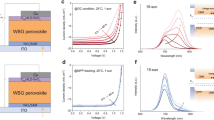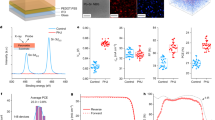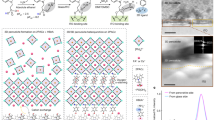Abstract
The solution process has been employed to obtain Ruddlesden–Popper two-dimensional/three-dimensional (2D/3D) halide perovskite bilayers in perovskite solar cells for improving the efficiency and chemical stability; however, the solution process has limitations in achieving thermal stability and designing a proper local electric field for efficient carrier collection due to the formation of a metastable quasi-2D perovskite. Here we grow a stable and highly crystalline 2D (C4H9NH3)2PbI4 film on top of a 3D film using a solvent-free solid-phase in-plane growth, which could result in an intact 2D/3D heterojunction. An enhanced built-in potential is achieved at the 2D/3D heterojunction with a thick 2D film, resulting in high photovoltage in the device. The intact 2D/3D heterojunction endow the devices with an open-circuit voltage of 1.185 V and a certified steady-state efficiency of 24.35%. The encapsulated device retained 94% of its initial efficiency after 1,056 h under the damp heat test (85 °C/85% relative humidity) and 98% after 1,620 h under full-sun illumination.
This is a preview of subscription content, access via your institution
Access options
Access Nature and 54 other Nature Portfolio journals
Get Nature+, our best-value online-access subscription
$29.99 / 30 days
cancel any time
Subscribe to this journal
Receive 12 digital issues and online access to articles
$119.00 per year
only $9.92 per issue
Buy this article
- Purchase on Springer Link
- Instant access to full article PDF
Prices may be subject to local taxes which are calculated during checkout




Similar content being viewed by others
Data availability
All data generated or analysed during this study are included in the published article and its Supplementary Information and Source Data. Source data are provided with this paper.
References
Best Research-Cell Efficiencies (NREL, 2020); https://www.nrel.gov/pv/assets/pdfs/best-research-cell-efficiencies.20200708.pdf
Green, M. A. et al. Solar cell efficiency tables (version 56). Prog. Photovolt. Res. Appl. 28, 629–638 (2020).
Liu, Y. et al. Ultrahydrophobic 3D/2D fluoroarene bilayer-based water-resistant perovskite solar cells with efficiencies exceeding 22%. Sci. Adv. 5, eaaw2543 (2019).
Cho, K. T. et al. Water-repellent low-dimensional fluorous perovskite as interfacial coating for 20% efficient solar cells. Nano Lett. 18, 5467–5474 (2018).
Yoo, J. J. et al. An interface stabilized perovskite solar cell with high stabilized efficiency and low voltage loss. Energy Environ. Sci. 12, 2192–2199 (2019).
Jung, E. H. et al. Efficient, stable and scalable perovskite solar cells using poly (3-hexylthiophene). Nature 567, 511–515 (2019).
Hu, Y. et al. Hybrid perovskite/perovskite heterojunction solar cells. ACS nano 10, 5999–6007 (2016).
Cho, Y. et al. Mixed 3D–2D passivation treatment for mixed‐cation lead mixed‐halide perovskite solar cells for higher efficiency and better stability. Adv. Energy Mater. 8, 1703392 (2018).
Lu, J. et al. Diammonium and monoammonium mixed‐organic‐cation perovskites for high performance solar cells with improved stability. Adv. Energy Mater. 7, 1700444 (2017).
Jeon, N. J. et al. A fluorene-terminated hole-transporting material for highly efficient and stable perovskite solar cells. Nat. Energy 3, 682–689 (2018).
Shin, S. S. et al. Colloidally prepared La-doped BaSnO3 electrodes for efficient, photostable perovskite solar cells. Science 356, 167–171 (2017).
Yoon, H., Kang, S. M., Lee, J.-K. & Choi, M. Hysteresis-free low-temperature-processed planar perovskite solar cells with 19.1% efficiency. Energy Environ. Sci. 9, 2262–2266 (2016).
Tsai, H. et al. High-efficiency two-dimensional Ruddlesden–Popper perovskite solar cells. Nature 536, 312–316 (2016).
Beznosikov, B. & Aleksandrov, K. Perovskite-like crystals of the Ruddlesden–Popper series. Crystallogr. Rep. 45, 792–798 (2000).
Ortiz‐Cervantes, C., Carmona‐Monroy, P. & Solis‐Ibarra, D. Two‐dimensional halide perovskites in solar cells: 2D or not 2D? ChemSusChem 12, 1560–1575 (2019).
Quan, L. N. et al. Ligand-stabilized reduced-dimensionality perovskites. JACS 138, 2649–2655 (2016).
Wang, Z. et al. Efficient ambient-air-stable solar cells with 2D–3D heterostructured butylammonium-caesium-formamidinium lead halide perovskites. Nat. Energy 2, 17135 (2017).
Li, P. et al. Phase pure 2D perovskite for high‐performance 2D–3D heterostructured perovskite solar cells. Adv. Mater. 30, 1805323 (2018).
Ma, C. et al. 2D/3D perovskite hybrids as moisture-tolerant and efficient light absorbers for solar cells. Nanoscale 8, 18309–18314 (2016).
Leng, K. et al. Molecularly thin two-dimensional hybrid perovskites with tunable optoelectronic properties due to reversible surface relaxation. Nat. Mater. 17, 908–914 (2018).
Xiao, J. et al. Pressure-assisted CH3NH3PbI3 morphology reconstruction to improve the high performance of perovskite solar cells. J. Mater. Chem. A 3, 5289–5293 (2015).
Chen, H. et al. A solvent-and vacuum-free route to large-area perovskite films for efficient solar modules. Nature 550, 92–95 (2017).
Cao, D. H., Stoumpos, C. C., Farha, O. K., Hupp, J. T. & Kanatzidis, M. G. 2D Homologous perovskites as light-absorbing materials for solar cell applications. JACS 137, 7843–7850 (2015).
Porter, D. A. & Easterling, K. E. Phase Transformations in Metals and Alloys (Revised Reprint) Ch. 4 (CRC, 2009).
Li, R. et al. Gibbs–Curie–Wulff theorem in organic materials: a case study on the relationship between surface energy and crystal growth. Adv. Mater. 28, 1697–1702 (2016).
Chen, P. et al. In situ growth of 2D perovskite capping layer for stable and efficient perovskite solar cells. Adv. Funct. Mater. 28, 1706923 (2018).
Lin, Y. et al. Unveiling the operation mechanism of layered perovskite solar cells. Nat. Commun. 10, 1–11 (2019).
Zhao, B. et al. High-efficiency perovskite–polymer bulk heterostructure light-emitting diodes. Nat. Photon. 12, 783–789 (2018).
Stolterfoht, M. et al. Visualization and suppression of interfacial recombination for high-efficiency large-area pin perovskite solar cells. Nat. Energy 3, 847–854 (2018).
Tress, W. Perovskite solar cells on the way to their radiative efficiency limit–insights into a success story of high open‐circuit voltage and low recombination. Adv. Energy Mater. 7, 1602358 (2017).
Tai, M. et al. In situ formation of a 2D/3D heterostructure for efficient and stable CsPbI2Br solar cells. J. Mater. Chem. A 7, 22675–22682 (2019).
Chen, Y. et al. Strain engineering and epitaxial stabilization of halide perovskites. Nature 577, 209–215 (2020).
Kim, H. et al. Optimal interfacial engineering with different length of alkylammonium halide for efficient and stable perovskite solar cells. Adv. Energy Mater. 9, 1902740 (2019).
Gunawan, O. et al. Carrier-resolved photo-Hall effect. Nature 575, 151–155 (2019).
Zhang, F. et al. Complexities of contact potential difference measurements on metal halide perovskite surfaces. J. Phys. Chem. Lett. 10, 890–896 (2019).
Galiana, B., Rey-Stolle, I., Baudrit, M., García, I. & Algora, C. A comparative study of BSF layers for GaAs-based single-junction or multijunction concentrator solar cells. Semicond. Sci. Technol. 21, 1387 (2006).
Chen, H. L. et al. A 19.9%-efficient ultrathin solar cell based on a 205-nm-thick GaAs absorber and a silver nanostructured back mirror. Nat. Energy 4, 761–767 (2019).
Almora, O., Aranda, C., Mas-Marzá, E. & Garcia-Belmonte, G. On Mott–Schottky analysis interpretation of capacitance measurements in organometal perovskite solar cells. Appl. Phys. Lett. 109, 173903 (2016).
Quintero-Bermudez, R. et al. Compositional and orientational control in metal halide perovskites of reduced dimensionality. Nat. Mater. 17, 900–907 (2018).
Schlipf, J. et al. Shedding light on the moisture stability of 3D/2D hybrid perovskite heterojunction thin films. ACS Appl. Energy Mater. 2, 1011–1018 (2019).
Sutanto, A. A. et al. Dynamical evolution of the 2D/3D interface: a hidden driver behind perovskite solar cell instability. J. Mater. Chem. A 8, 2343–2348 (2020).
Anaraki, E. H. et al. Highly efficient and stable planar perovskite solar cells by solution-processed tin oxide. Energy Environ. Sci. 9, 3128–3134 (2016).
Kim, S.-Y. et al. Excitation dynamics of MAPb (I1–xBrx)3 during phase separation by photoirradiation: evidence of sink, band filling, and Br-rich phase coarsening. J. Alloy. Compd. 806, 1180–1187 (2019).
Acknowledgements
This work was supported by the National Research Foundation of Korea (NRF) grant funded by the Korea government (MSIP) (grant nos. NRF-2020R1A2C3009115, NRF-2017M1A2A2087351 (the Technology Development Program to Solve Climate Changes); NRF-2017R1A4A1015022) and the New and Renewable Energy Core Technology Program of the Korea Institute of Energy Technology Evaluation and Planning (KETEP) from the Ministry of Trade, Industry and Energy (grant no. 20183010014470). This work was also supported by the Global Frontier R&D Program of the Center for Multiscale Energy Systems funded by the National Research Foundation under the Ministry of Education, Science and Technology, Korea (grant no. 2012M3A6A7054855). The authors thank S.-j. Park (Korea I.T.S.; XRD instrumental broadening calculation), W.-S. Chae (Korea Basic Science Institute; TRPL mapping) for their help during the course of the study.
Author information
Authors and Affiliations
Contributions
Y.-W.J., S.L., M.C. and J.H.N conceived the idea and interpreted the data. Y.-W.J. and S.L. shaped and optimized the SIG process. Y.-W.J. synthesized and analysed 2D perovskite powder and film. S.L. and Y.-W.J. performed the fabrication and characterization of the PSCs with support from K.M.Y. and K.C. S.L. and Y.-W.J. estimated the long-term stability of films and devices with encapsulation by K.J. All authors participated in the discussion. Y.-W.J., S.L., M.C. and J.H.N. wrote the manuscript. J.H.N. and M.C. supervised this project.
Corresponding authors
Ethics declarations
Competing interests
The authors declare no competing interests.
Additional information
Peer review information Nature Energy thanks Pablo Docampo, Wanyi Nie and the other, anonymous, reviewer(s) for their contribution to the peer review of this work.
Publisher’s note Springer Nature remains neutral with regard to jurisdictional claims in published maps and institutional affiliations.
Supplementary information
Supplementary Information
Supplementary Figs. 1–23, Tables 1–6, Notes 1–4 and references.
Supplementary Data 1
Photovoltaic parameters of solar cell presented in Supplementary Table 4.
Supplementary Data 2
SIG-2D thickness and calculated built-in potentials presented in Supplementary Table 5.
Source data
Source Data Fig. 1
SIG-(BA)2PbI4 thickness with processing time shown in the Fig. 1h.
Source Data Fig. 2
Normalized PCE of solar cells shown in Fig. 4c,d.
Rights and permissions
About this article
Cite this article
Jang, YW., Lee, S., Yeom, K.M. et al. Intact 2D/3D halide junction perovskite solar cells via solid-phase in-plane growth. Nat Energy 6, 63–71 (2021). https://doi.org/10.1038/s41560-020-00749-7
Received:
Accepted:
Published:
Issue Date:
DOI: https://doi.org/10.1038/s41560-020-00749-7
This article is cited by
-
Frequency-selective perovskite photodetector for anti-interference optical communications
Nature Communications (2024)
-
Double-side 2D/3D heterojunctions for inverted perovskite solar cells
Nature (2024)
-
Multifunctional sulfonium-based treatment for perovskite solar cells with less than 1% efficiency loss over 4,500-h operational stability tests
Nature Energy (2024)
-
Bridging buried interface enable 24.67%-efficiency doctor-bladed perovskite solar cells in ambient condition
Nano Research (2024)
-
Unveiling the surface-interface properties of perovskite crystals and pivotal regulation strategies
Nano Research (2024)



